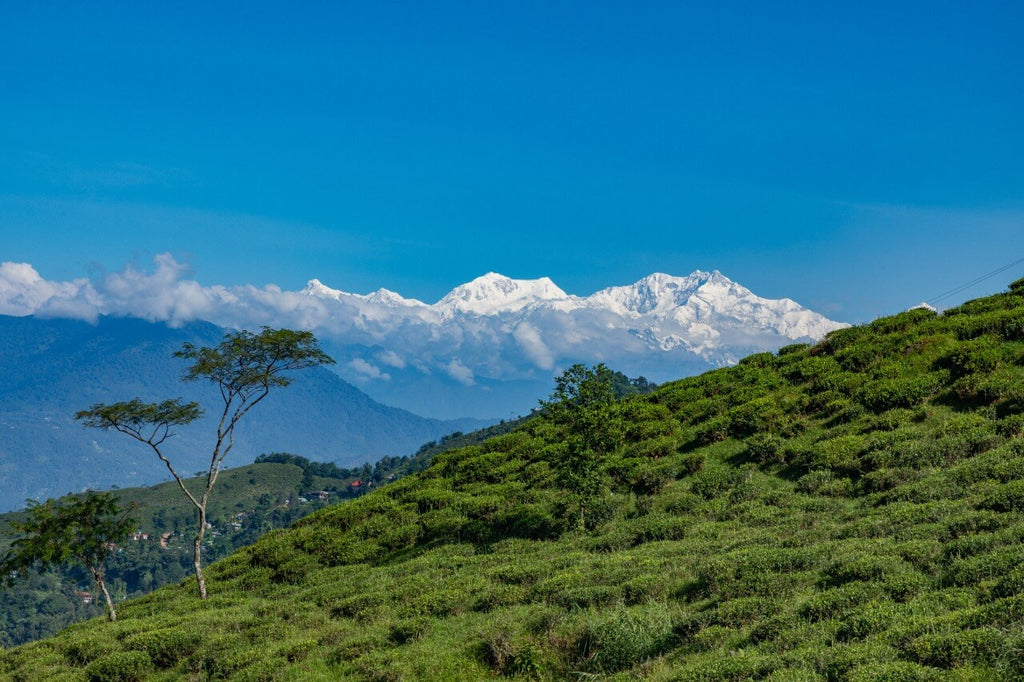No Products in the Cart

The answer is: if you like the tea and feel you are happy with its price, it is a good tea. But to be more scientific, the quality of a tea depends upon the plant, the skill of the farmer/producer, and the terroir (a fancy French word for the environmental conditions in which the tea was grown). One element of terroir is the altitude at which the tea is grown (the other elements being the soil, climate, and geographic location), and altitude will be the focus of this blog post.
If you’ve been around tea enough, you’ll see teas advertised as ‘high altitude tea’ or ‘high mountain tea,’ some of which command a high price to go with it. The highest-altitude teas are produced in Dayulin, Taiwan, at altitudes between 2200-2700 m, but generally, high-mountain natural teas are grown above 1000 m.
So, what about high altitude makes a tea special, and how does the altitude affect the tea? Read on to find out.
Fundamentally, the tea plant draws its energy from the sun, water, the air, and nutrients in the soil. Suppose the plant has an abundance of the energy sources it needs (i.e., under optimal growing conditions at lower altitudes). In that case, the plant can easily use this energy to grow quickly and robustly, resulting in a large, high-yielding plant. At high altitudes, however, the plant faces harsh growing conditions. High altitudes result in lower temperatures, more UV exposure but less sun exposure (foggy mountain conditions block the visible sunlight but let the UV through, which can ‘sunburn’ the leaf), rockier soil (so there are generally fewer nutrients available and harder for the plant to establish strong roots), less oxygen (because higher altitudes have less air), and less water (as it all runs downhill).
To survive, the plant has to engage all its defense mechanisms and use its resources as efficiently as possible. For example, the plant will use the carbohydrates stored in its roots to help power its growth, which adds a sweet, creamy profile to the tea. These conditions mean the plant grows more slowly, resulting in a smaller, lower-yielding plant. But it also means the plant has a much more intense concentration of essential oils and complex chemical compounds, leading to a wonderful array of flavors and aromas. So, as with life, the harder we work for something, the greater the reward. This is what makes high-altitude tea so great.
You will like to read: How do differences in the Indian terroir influence the mouthfeel and flavors of the tea you drink?
The cloud cover helps increase the concentration of the L-theanine in the tea leaves. L -theanine is well known for its benefits in reducing anxiety and acute stress. L-theanine, also known as, is produced in the roots and stored in the winter season. In spring, it is transported to the young shoots where, under sunlight exposure, it is broken down into glutamic acid and ethylamine, which is used to synthesize catechins. High in the mountains, where there is often more cloud cover and less intense sunlight, this degradation of L-theanine is decreased, resulting in increased concentrations.
There are also ecological advantages of being at high altitudes, including fewer insects. This means that the bitter compounds produced by the plant to defend against insect attacks are reduced, resulting in a smoother tea. It also means that the farmer doesn’t need pesticides and can produce an organic product more easily. Finally, remote geographical mountainous locations likely mean less ‘city’ pollution in the air and soil and more natural biodiversity surrounding the tea plants.

So why do high-altitude teas command such a high price? This is mainly because growing tea at high altitudes is harder and less cost-effective. As mentioned previously, the yield from the tea plant is much less than those grown at low altitudes as the plant grows much more slowly and produces smaller leaves. The harsh conditions also make the crop much more likely to fail, which can further reduce the yield.
This means a farmer cannot sell as much tea in a season as a farmer growing at lower altitudes could. The remote mountain location and steep slopes also mean it is much harder to farm, and there is likely less infrastructure to transport the tea, equipment, and labor up and down the mountainside. To make it worthwhile, the farmer must charge more. But be warned, just because a high mountain oolong tea or green tea are grown at a high altitude doesn’t automatically mean it is great. The farmer still needs to know which cultivar to grow, how to best care for the plant, and how to process it with great skill and knowledge, just as with any other great tea.
Now that you have an understanding of what can make high altitude teas so great. Try one of our high mountain Darjeeling teas grown in Mirik Valley.